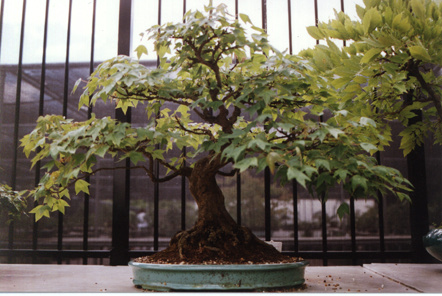![]() Click here to return to Roo's Home Page
Click here to return to Roo's Home Page

(From Ray Nesci's Private Collection)
A Bonsai is basically a tree that appears to be much old and taller than it really is (i.e. a miniaturization). Typically kept by their owners in small pots (hence the name bonsai - potted tree).
Bonsai can be produced by several means. Bonsai can occur naturally where the growth of a tree is restricted by such natural elements as rocky terrain, grazing animals or precarious, wind swept locations, etc.
A "Good" bonsai, can really be any tree that is healthy, is dwarfed (according to it's natural height), and gives a strong illusion of age and magesty. All trainers of bonsai are really artists, striving to give the best possible illusion of maturity, magesty and natural beauty, but within a small context.
This is mainly of interest to people with little horticultural experience that may have been given a bonsai as a gift or somehow been given the responsibility of looking after a bonsai.
Bonsai are REAL trees, and they typically have the same requirements as their full size conterparts. For instance, an elm, ash, liquidamber, juniper, cottoneaster and other trees are outdoor plants and will not tolerate being kept within the house for very long. Other trees like figs will not tolerate frosts. So to care for a bonsai, you must learn about the individual requirements for the type of tree it is.
The only other guides to bonsai care are really the amount of watering, fertilizing and care of wiring. Watering a bonsai depends very much (again) on the type of tree but as a general guide, a good water once a day for a well draining pot is a good starting point. Appearance of liverwort (sort of like lilly pads) on the soil probably means poor drainage or slight over watering, remember... overwatering can do more damage than underwatering. Dry, flakey soil and brown moss are obvious signs of underwatering. Fertilizer is used in lower doses than for normal pot plants and more often applied (or use slow-release pellets) as the small pots and frequent watering means nutrient is flushed quickly. Lastly, remember to check wiring periodically and remove wire BEFORE it starts biting into the bark, wire wounds can take a long time to heal.
Bonsai Boy of New York (USA) | New York Nursery - Sales, special deals (and some nice pictures). |
Horyokuen's Bonsai Nursery (Japan) | Japan Nursery - Sales, care notes, great pictures, club info, etc. |
Brian Inglis Bonsai Page (in Australia) | Some good samples of Bonsai in Australia. |
Rick Raygor's Bonsai Related Bookmarks | Links to other sites. |
Thanks for visiting my bonsai page. Last updated -
If you have corrections or comments concerning my bonsai page,
please send e-mail to: